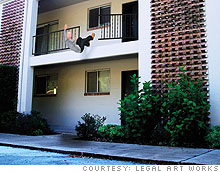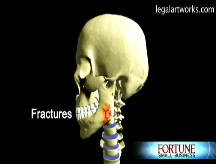Courtroom cartoons help win legal fights
How digital animation entrepreneurs make a legal killing.
| A still from a Legal Art Works animation |
 |
| This powerful animation helped win a secret seven-figure settlement for the injured plaintiff. |
(Fortune Small Business) -- An animated video shows a woman jogging by the side of a road - until a wayward car sends her flying into the grass. In another, a motorcycle crashes into a truck parked in the bicycle lane at twilight. In a third, the pipes in an attic tilt, causing moisture to collect and creating mold that spreads spores through the house and into the inhabitants' lungs.
You won't be seeing those cheery flicks at your local multiplex, but you might in a courtroom. Legal Art Works, based in Jacksonville, produced them to help its clients win - or stave off - multimillion-dollar litigation payouts.
Animation has long served as a powerful tool in the courtroom. What better way to explain a complex series of events to a jury? The cost, however, used to be prohibitive for all but the most high-profile firms. Now cheaper, faster computing power has led to a litigation-animation boom.
According to the American Bar Association, 25% of firms with 50 to 99 attorneys used the technology in 2007, vs. 4% in 2006. More than 20 small businesses currently provide one-stop shopping for accident reconstruction, medical illustration, and animation services. Legal Art Works charges between $5,000 and $20,000 for its videos, 25% of which is pure profit. Founded in 2003 by Jeff Davis, a former medical illustrator, the company's revenues have doubled every year, hitting $500,000 in 2007.
Today's legal animations are extraordinarily sophisticated compared with their predecessors.
"A red rectangle sliding across the screen used to represent a fire truck," says Davis, 36. The latest works feature 3-D computer graphics that rival those in Shrek (if Shrek were under indictment). Typical subjects include patent-infringement cases, medical malpractice claims, and serious highway accidents.
"Fender-benders don't really make it to our door," says Davis. "Our assignments tend to be more interesting - a guy falling from the balcony of a million-dollar high-rise, a car flying off a racetrack."
The fun factor aside, legal animation is a serious business. Get the slightest detail wrong and your movie could be thrown out of court - or even lose your client's case. Courts scrutinize all video evidence, and if your animation claims to simulate an actual event rather than a generic process, it will be held to an even higher standard. Says Elan Weinreb, a litigation associate at the Kaye Scholer firm in New York: "You have to go to the accident scene and measure the tire marks."
To ensure precision, legal-animation producers hire experts from a variety of fields, including physics, architecture, and mathematics. Demonstratives, a $3-million-a-year legal-animation business based in Ames, Iowa, is the brainchild of a group of scientists.
"Everyone here has a technical bent," says co-founder Dan Krueger, a Ph.D. in mechanical engineering. To recreate accidents, staff analysts painstakingly sift the evidence, then pass their instructions on to animators and medical illustrators, who produce the video. The process can take anywhere from a week to a couple of months.
Emotional weight
Experience has shown that juries can be influenced by subtle visual cues.
"If we're representing a fracture for the plaintiff, we might add texture and reddishness, to represent pain," says Davis. "But if we're defending a doctor against a similar malpractice, we'd use more sterile hues."
Adding audio of taped depositions also boosts the emotional weight of the animations. "The jury steps into your client's shoes," says Weinreb. "Once they do that, you have them eating out of your hand."
Still, experts such as Weinreb advise businesses to avoid creating works that are overtly manipulative. According to the Federal Rules of Evidence, visual aids with certain emotional impact - crime scene photos, bloody images - carry a "danger of unfair prejudice" and may be thrown out of court.
In some instances an entire case may be lost over an animation. Last April an appeals court in Chicago threw out a $17 million verdict granted in 2006 to the husband of Dorota Spyrka, who had suffered a fatal blood clot. The judges ruled that an animation had been admitted into evidence that claimed to be an exact simulation of what had happened to Spyrka. In fact, they wrote, it was an animation of a generic pulmonary embolism.
Opposing lawyers will do whatever they can to discredit video evidence, of course. Demonstratives' science-savvy employees are called regularly to testify in court as to the accuracy of animations by other companies, and they have caused several videos to be thrown out.
"One showed a car with locked brakes skidding around a curve," recalls Krueger. That one was easy to dismiss, he says: "Such a car would skid in a straight line." And if having work thrown out because of the testimony of rival animators isn't humiliating enough, there's the possibility of defeat by imitation.
"The other side can introduce a counter-animation to disprove you," Weinreb says.
Despite such risks, the rewards can be great. In Sprint-Nextel's (S, Fortune 500) 2005 lawsuit against Vonage, Demonstratives created an animation explaining how Vonage's (VG) VoIP technology infringed on Sprint's patents. That trial yielded an $80 million verdict for Sprint. Jurors said afterward that without the animation, they would never have understood the technical issues in question.
"Animation is a growing market," says Mark McGory, Demonstratives' general counsel. "More and more lawyers appreciate that they need this tool to persuade a judge and jury."
The vast majority of Legal Art Works animations never see a courtroom. Instead, a settlement is reached, usually in favor of Davis's clients.
"When we show those on the other side a good animation, they'll say, 'I don't want the jury to see that,'" says Davis.
As the technology becomes more pervasive, he believes that both sides of every case will bring animations to the table and that more legal-animation companies will spring up. But with a market of more than a million lawyers practicing in the U.S., Davis isn't afraid of the competition, as long as Legal Arts' work is the better of every double feature.
Editor's Note: An earlier version of this year included an incorrect date for Sprint's lawsuit against Vonage. FSB regrets the error. ![]()
See Legal Art Works animations in action: Watch the video
Your stay-out-of-court guide: Avoid costly traps that often ensnare small business owners.
The Virtualization of Emily: The cutting edge of digital animation.
Hollywood on the Plains: Iowa City
-
The Cheesecake Factory created smaller portions to survive the downturn. Play
-
A breeder of award-winning marijuana seeds is following the money and heading to the U.S. More
-
Most small businesses die within five years, but Amish businesses have a survival rate north of 90%. More
-
The 10 most popular franchise brands over the past decade -- and their failure rates. More
-
These firms are the last left in America making iconic products now in their twilight. More









